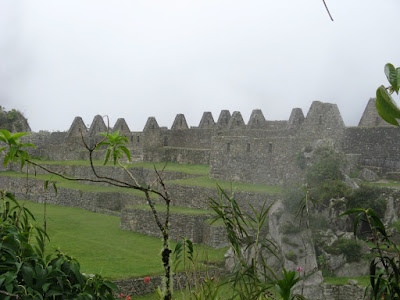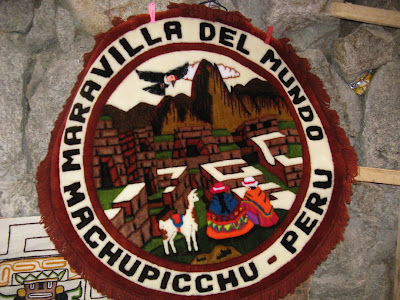Crazy Train
I was picked up from my hotel at 6:30 am so we could catch the 7 am train to Aguas Calientes. The train was an experience in itself. We set out from the station and less than 10 minutes later the train comes to a halt that makes most people jump a foot off of their seats. Then, a few seconds later, it clunks back to a start... in the direction we had just come from? All of the passengers are looking around at eachother "What the heck is going on?" Then the attendent comes along and tells us that we've actually switched to another track, that switches back the other way. Essentially we have to make zigzags up and over the mountains- back and forth, back and forth. Sure enough, another 10 minutes later, another rough stop, then start. So much for sleeping on the train... Thankfully the switchbacks didn't go on for the full four hours, but there were about 6 in the first hour and a bit.
Way up there
The altitude of Cusco city itself is about 3,400 m (~11,000 ft). It's quite common that people experience "altitude sickness" when they first arrive there, which involves feeling dizzy, tired and out of breath due to the decrease amount of atmospheric oxygen at this altitude. The day I arrived I was exhausted and feeling pretty sick, so I slept all day and feel anything that was discernibly altitude sickness. Machu Picchu itself is at 2350 m (7,970 ft) which is slightly lower of course, but still pretty high. To give you Salmon Arm folks an idea, SA is at 415 m (1,360 ft)- quite a difference. Even Rogers Pass (in the Rocky Mountains between Vancouver and Calgary) is only at 1,300 m (4,360 ft).
So when you start walking around Cusco or Machu Picchu, say up a few steps, you can definitely feel it. But everyone's huffing and puffing, so it's okay. This is where the coca plant comes in. Andean people both make tea out of and chew coca leaves to help them deal with the altitude. No, there is no “drug” effect, but it is also supposed to help to suppress hunger and tiredness. For these reasons it is very often used by those who work at this altitude. I was also very interested to learn it is high in calcium and proteins. Subsequently, osteoporosis is non-existent in these populations. I actually still haven’t tried chewing the coca leaves, but I do love the Mate de Coca tea and the coca caramels.
First Glimpse
I found my "Orange Flag" man when I got off the train in Aguas Calientes, as instructed by the guy who had taken me to the train station. He whisked me and three other people off through the crowd and to where the buses leave to go up the mountain to Machu Picchu. I was already starting to get a sense of chaos at this point. Hundreds of people had just arrived by train and probably 95% of them were headed in the same direction as I was. The bus filled up quickly and then started up the mountain. Many switchbacks and blind corners later (I wonder how many bus accidents happen on that stretch…?) we arrived at the control gate to Machu Picchu. I joined the orange flag group and our enthusiastic guide and we headed through the gates. Around the corner and here is what you first see:

Machu Picchu, meaning old mountain is actually the name of the mountain that this “Lost City” is located on. The city was built in the 1400s A.D and was the home of approximately 1000 Incans and their ruler Pachacuti. The Incas are known for their architectural skills, agricultural abilities and astronomic interests. The entire “city” is built with huge rocks that are carved, shaped and assembled as bricks with amazing precision. Going up the side of the mountain are terraces that look like giant steps. The rock walls retain not only provide the space to grow the crops, but also prevent erosion of the land. The idea of these terraces is that each has its own micro-climate, which is preferred by a specific crop.
The reason this is called the “Lost City” is that it was actually never found by the Spanish Conquistadores who arrived in the 15th century. As they took over the Incan empire, the Spanish forced their Catholic religion onto the Incan people as well as destroyed or at least damaged many of their cities, temples and structures. The city at Machu Picchu remained untouched until an American archeologist came across it in 1911 when he was led their by a local guide and a small boy. Since then there has been a great amount of archeological research on the site, including the recovery of thousands of tools and artifacts, most of which are in a museum at Yale University in the States. There has also been a good amount of reconstruction and restoration of the site. It is now considered one of the Seven Wonders of the World.
Despite the chaos, I was happy to be part of a guided group. It is definitely a good way to get more information and a better understanding the ruins. This way you can also be sure to see all of the major points of interest. Below is only a fraction of the 150+ photos that I took in the three hours that I was at Machu Picchu, but I think it’s a pretty good representation of what I saw.
Pouring Rain
Right now is Peru’s summer, but it is also the rainy season in the mountains. Unfortunately, within 10 minutes of getting in, it started to pour rain. I had opted to not buy one of the plastic “ponchos” that were being sold down below and brought some extra clothes instead. Unfortunately, I hadn’t thought far enough ahead to bring my rain jacket from home…
Take a look at this photo: one interesting thing that came of it dumping rain was that you could see how the Inca’s drainage system worked- look at the water pouring out of this one hole in the wall (top left corner).


The rocks used to build the temples are very squared and the corners fit snugly together. They did not use any sort of mud or mortar between them. However, there are some copper and metals dowels to hold the rocks together.

About 95% of the city is built with this less-precise architecture- though still very strong and sturdy.

 The next mountain (right) is called Waynu Picchu, the young mountain. You can also hike up to the top of it and get a different view over Machu Picchu. They have recently begun restricting the number of people that go up each day to 400 and apparently it had already “filled up” at 8 am that morning. Many people come up the day before and spend the night at Aguas Calientes so they can take the early buses up to Machu Picchu and catch the spectacular sunrise and usually clear skies.
The next mountain (right) is called Waynu Picchu, the young mountain. You can also hike up to the top of it and get a different view over Machu Picchu. They have recently begun restricting the number of people that go up each day to 400 and apparently it had already “filled up” at 8 am that morning. Many people come up the day before and spend the night at Aguas Calientes so they can take the early buses up to Machu Picchu and catch the spectacular sunrise and usually clear skies. Many of the buildings at Machu Picchu did originally have roofs, however only a few have been reconstructed as a demonstation.
Many of the buildings at Machu Picchu did originally have roofs, however only a few have been reconstructed as a demonstation.
After finishing the 2 hour guided tour, I wandered around for another hour by myself. The rain had scared off the majority of people and quite quickly it was much much quieter. I walked up to the lookout point, which we had not done on the tour. At a lower altitude it probably only would have taken about 5 minutes to ascend, but I found myself having to take about 3 breaks on the way up. It’s a really strange feeling to be so winded when you know you’re not really physically over-exerting yourself!

 So the rain did stop after about 45 minutes, but then the fog rolled in. It was actually pretty amazing to stand at the top of the look out and watch the fog roll over the city. At some points it was almost impossible to see anything below.
So the rain did stop after about 45 minutes, but then the fog rolled in. It was actually pretty amazing to stand at the top of the look out and watch the fog roll over the city. At some points it was almost impossible to see anything below.

Overall, seeing Machu Picchu was a pretty magical experience. I did enjoy the guided tour, but also appreciated having some quiet time afterwards to take it all in. It’s too bad the weather wasn’t nicer, but there was something pretty mystical about the fog and clouds.
I took the bus back down to Aguas Calientes and arrived about an hour and a half before my train was scheduled to leave to go back to Cusco. I had some lunch and then wandered around the market near the train station. It was amazing how much stuff they had for sale! Sweaters, blankets, socks, toques, gloves, jewelry and all sorts of trinkets and souvenirs.

The train pulled out right on time at 5 pm. When we finally made it back to Cusco and were making the switchbacks down the mountainside, the view of the lights was spectacular. Cusco is a huge city with about 300,000 habitants (and who knows how many thousands of tourists!) and the lights sprawl up into the mountains. By the time I got back to my hotel it was almost 10 pm, about 16 hours after I’d left that morning. A long, but satisfying day.













No comments:
Post a Comment